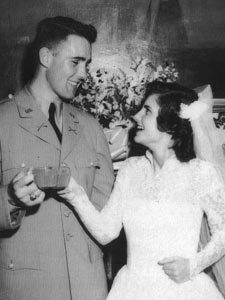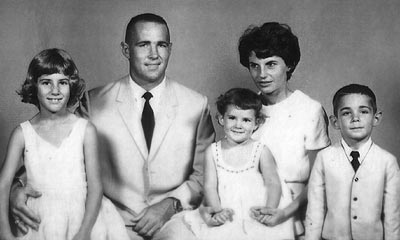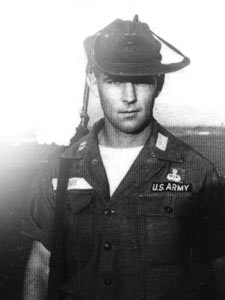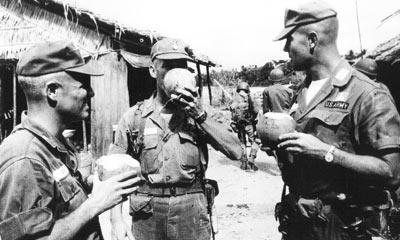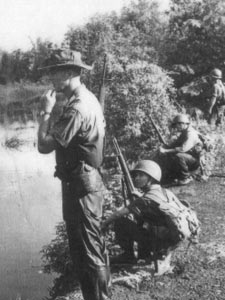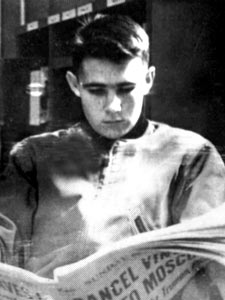| |
|
|
|
Kenneth Newlon Good
Captain
ARMY ELEMENT, MAAGV Army of the United States San Marino, California November 30, 1930 to January 02, 1963 KENNETH N GOOD is on the Wall at Panel 1E, Line 15 See the full profile or name rubbing for Kenneth Good |

   |
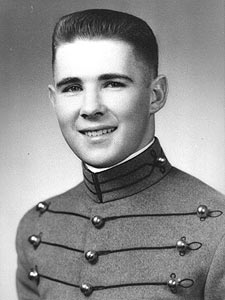
|
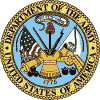
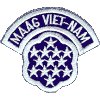
| |
Kenneth Newlon GoodMy father, Kenneth Newlon Good, was born on November 30, 1930 in Hollywood, California. He was raised in the town of San Marino, California, where he spent his early childhood playing "army", "cowboys and Indians", football, baseball and soccer. He later acquired a passion for weight lifting and surfing. He graduated from South Pasadena-San Marino High School in 1948. Dad was known as a quiet, honest and hard-working young man. In 1948 my father received his appointment to West Point by Senator Richard M. Nixon. Dad found himself quite discouraged upon first entering West Point, but his parents urged him to persevere through that first year. He proudly graduated with the class of 1952. During his four years at West Point Dad was a member of the Weight Lifting Club and played soccer for three years. In his last year at the Academy Dad met my mom, Barbara May Waterhouse, from Kaua`i, Hawai`i. They were married in Crestwood, New York, in June of 1952. Upon his graduation from West Point Dad was assigned to a paratrooper unit where he became a qualified paratrooper and graduate of the Infantry Officer's Advance Course at Fort Benning, Ga. He also served with the 7th Infantry Division in Korea, as well as posts in Japan and on the Mainland. In 1958 dad accepted an assignment as assistant professor of military science in the senior ROTC group at the University of Hawai`i. By this time dad and mom had three children: Leona (1953), Chuck (1956) and me, Lori (1958). In 1962 dad volunteered for a tour in Viet Nam. He served as a senior advisor with the 7th Infantry Division in My Tho under Lt. Col. John Vann. His reasons for volunteering for Viet Nam can best be said in his own words in a letter that he wrote to his parents in July, 1962 (two weeks before leaving):
On January 2, 1963 dad was hit by an enemy sniper bullet as he attempted to rally a stalled Vietnamese unit against the Viet Cong in the village of Ap Bac. Col Chinh, his Vietnamese counter part, attempted to call for an air evacuation; but my father, who was not fully aware of the extent of his wound, discouraged Col Chinh from making the call, as he did not want to endanger the lives of others around him. Dad died a few hours later. He was buried at the National Memorial Cemetery at Punchbowl in Hawai`i. Kenneth Newlon Good has been greatly missed. He was a man of impeccably high moral standards, he was honest, courageous, dedicated, loyal and devoted-but most of all he was a wonderful husband and father.
Lori Good Dill
|
A Note from The Virtual WallThe 02 Jan 1963 fight at Ap Bac, a hamlet located in Kien Tuong Province southwest of Saigon, was a catastrophe from start to finish:
The ARVN were supported by American advisors and American helicopter support - the latter from the 145th Aviation Battalion's UTT Company (UH-1) and 93rd Transportation Company (CH-21). Five UH-1s acted as gunships, while the 93rd's ten CH-21s provided airlift. The MAAGV advisors could only advise - they could not command. Although the senior advisor, LTC John P. Vann, argued against the employment of forces, the ARVN commanders chose not to follow his advice. It is difficult in retrospect to second-guess either American advisors or ARVN commanders, but the fight can only be described as a VC win. Despite being grossly outnumbered and outgunned, the VC traded 18 known dead for 60+ ARVN dead and 3 Americans - and withdrew safely to the east when their position became untenable. The Americans killed at Ap Bac were
"It was a miserable damn performance" was the way one American military man summed up the humiliating and costly defeat suffered by the South Vietnamese army at the hands of outnumbered Communist guerrillas in the fight for the jungle hamlet 30 miles south of Saigon.
It was perhaps the strongest criticism by an American military adviser, but others in the battle said it was not an unfair one.
They spoke of the marked "lack of aggressiveness" of Vietnamese commanders, their refusal to heed recommendations of their American advisers, refusal to carry out orders from their superiors and a breakdown in the chain of command of the 7th Vietnamese Division.
As a result, the American sources said, the government troops suffered a needlessly high casualty toll, 65 dead and at least 100 wounded, the second highest since the war against the Communist Viet Cong began.
American advisers who took part in the battle on the edge of the Plain of Reeds recounted sorry tales of the debacle: Government forces out numbered the Communists by 10 to 1 and were supported by planes, artillery and armor.
Yet an infantry battalion located less than a mile from Ap Bac flatly refused to advance on the hamlet even though Vietnamese and American officers at division headquarters ordered and pleaded for hours. About 200 guerrillas held Ap Bac.
The battalion commander had been killed and the other officers refused to assume command. Capt. Good was killed while out in front trying to get the Vietnamese to attack.
A Vietnamese captain commanding an armored-personnel carrier company refused for 70 minutes to cross a canal to rescue downed U.S. helicopter crewmen and a company of Vietnamese infantry pinned down by small arms fire.
The captain kept complaining about "heavy enemy fire," even though U.S. advisers urged him to advance because the small arms fire could not penetrate the armored vehicles. He finally gave in to radioed orders and pleading from U.S. and Vietnamese officers and rescued most of the Vietnamese and American wounded.
Then the captain attacked twice but retreated after Communist fire kept picking off exposed machine gunners on the armored cars. U.S. advisers said the captain should have "buttoned up" the armored vehicles and run over the Viet Cong forward positions as he had been trained to do.
Most of the Communists were able to withdraw from the hamlet during the night because a paratroop battalion was dropped on the west side of the hamlet instead of the east, leaving an escape route into the jungles.
An American general narrowly escaped being killed when Vietnamese artillery accidentally shelled their own troops after the fight was over.
The advisers said American patience came to an end Friday when a civil guards company failed to move into a blocking position as ordered, leaving a U.S. Army major alone in a paddy field to face guerrilla stragglers.
Lt. Col. John Paul Vann, senior U.S. adviser with the 7th Vietnamese Division, quickly rounded up 60 American advisers, cooks and communications men from his headquarters and sent them to the aid of the major.
The Americans were under strict orders not to fire unless fired upon. They rescued the major and captured 17 guerrillas without suffering any casualties and then returned to their regular duties.
One U.S. adviser said bitterly, "These people (the Vietnamese) won't listenï¿ 1/2 they make the same mistakes over and over again in the same way."
From the |
| Contact Us | © Copyright 1997-2019 www.VirtualWall.org, Ltd ®(TM) | Last update 08/15/2019. |
